Archive for December, 2008
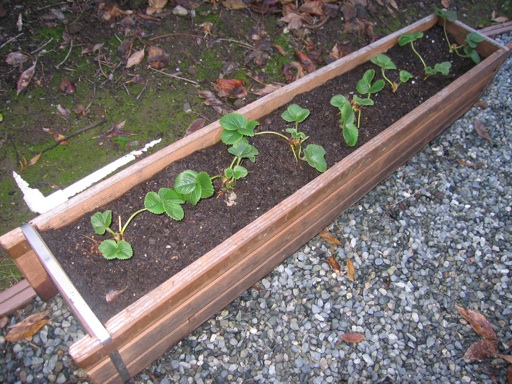
Strawberry plants proliferate by sending out runners that look like vines. The runners grow and develop roots that form new strawberry plants. Last summer, I let our strawberries send their runners into the raised beds where we grow our vegetables, because I wanted to get more strawberries for next year. The strawberries are growing in about ten pots next to the raised beds.
I spent part of the day yesterday and today transplanting most of the runner sets into pots, as in the picture above. Strawberries transplant incredibly well. I often tear off many of the roots in the transplanting process. They don’t seem to mind though. The strawberries don’t wilt or show any sign of transplant shock even after multiple transplants.
I also trimmed the new and old strawberry plants. The older plants look especially scraggly right now. They are full of dead and yellow leaves. I cut off most of the leaves of each plant, including many of the green leaves, leaving just the newly developing leaves. It seems that trimming the strawberries each winter helps stimulate them to regenerate in the spring.
After about 3 years, strawberries begin to produce fewer berries. I keep individual strawberry plants about 3-4 years before discarding them. I don’t think that growing them as annuals is the best method. In general, our strawberries have reached their peak production of berries at about 2 years from the time they rooted as runners. I don’t see the point of throwing away good plants until they are past their peak. We are growing Sequoia strawberries. Sequoia is a particularly tasty variety that grows well in California.
I am still toying with the idea of leaving some of the strawberry runners to grow in one of the raised beds. I have had a lot of success so far with growing strawberries in pots. Although, I have a tendency to plant them too close together in the pots. I keep underestimating how large they will get, so they end up looking crowded. I think I will plant just one row of them in one of the raised beds with each plant about 12 inches apart, and then judge how well they perform in 2009. Hopefully, they won’t proliferate like mad and take over the garden.
December 29 2008 | Strawberries | Comments Off on Transplanting Strawberries
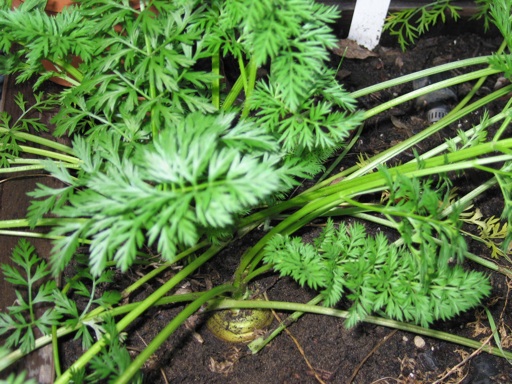
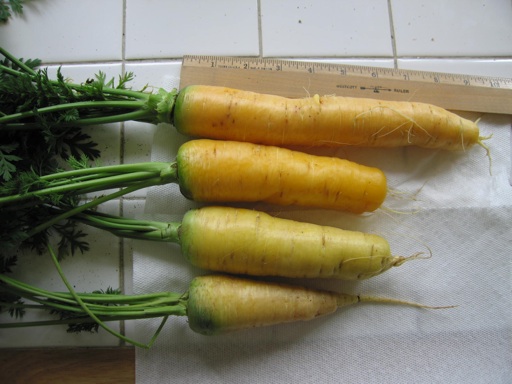
Nearly all of the plants in our vegetable garden are dead or dying. The one exception is the carrots I planted by seed last summer. We planted yellow and red carrot seeds, because we thought they would be interesting novelty plants. The carrots look healthy right now despite the cold weather we have been having.
Several nights last week, the temperatures here fell into the low 30s F. The frost damaged the leaves of our brugmansia and plumeria plants. However, the carrots appear to have been unaffected by the cold temperatures. The leaves still look green and healthy. The high temperatures here have been in the upper 40s to low 50s for weeks.
Today, I harvested our first carrots, shown in the above pictures. Obviously, one doesn’t know what an individual carrot will look like until it’s uprooted. So I was very excited to pull them out of the ground and discover nicely developed carrots attached to the leaves. The surprise factor adds an interesting dimension to growing carrots. These appear to be yellow carrots. The largest one is about 9 inches in length. The thickest one is about 1.75 inches in width. I can’t wait to taste them. We are going to serve them for Christmas eve dinner. I haven’t grown carrots since I was a child, and I remember not having much luck with them back then.
I have read that one of the keys to growing carrots is to grow them in at least a foot of loosely packed soil that is free of rocks. Otherwise, the carrots may not develop to their full length or may develop forks. Growing them in a foot-high raised bed filled with compost seems to have helped.
December 23 2008 | Carrots | Comments Off on Yellow Carrots
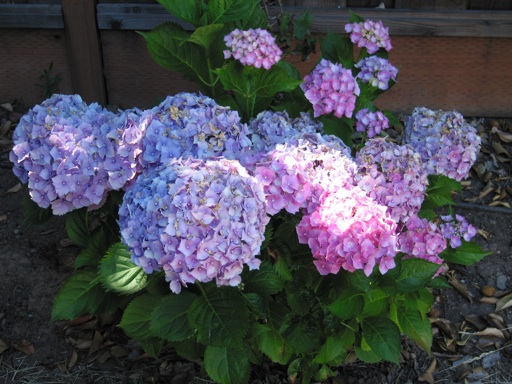
This time of year there’s not much fruiting or blooming in our yard. The few plants that are blooming are not exactly photogenic. So I included some photos of a few of the bigleaf/garden hydrangeas that were blooming in our yard last summer.
Hydrangeas must be one of the most beautiful of garden flowers. Their eye-catching mass of colorful flowers last for weeks in June and July before fading gradually, or more suddenly when a heat wave hits.
When the inevitable heat wave occurs our area in June or July, our bigleaf hydrangeas wilt badly. Every time it happens, I water them excessively to rejuvenate them, but they never fully recover their original beauty. Instead, the flowers and leaves get burnt edges that get larger with each additional hot spell, as shown in the above picture of one of our hydrangeas taken back on June 22. Even under typical weather conditions, hydrangeas need a lot more water than most of our garden plants.
But during hot weather (90s F), I have not been able to prevent them from wilting. I have transplanted most of our hydrangeas from partly shady locations into the few locations in our yard that receive shade nearly all day long. The hydrangeas growing in the shade still wilt in hot weather, but not as severely, even though they are being watered daily. I am coming to the conclusion that bigleaf hydrangeas are not ideally suited to our climate despite the fact that the average high temperature in the summertime here is only in the upper 70s F. Despite the wilting, I like hydrangeas so much that I keep them anyway.
One of the interesting things about hydrangeas is that the flowers never seem to fall off. The color just fades to gray or brown over a period of months. Even in December, our hydrangeas still have flowers on them, but they are unattractive looking. The two pictures below show one of our purple hydrangeas. I took the first picture on July 4, and I took the second picture today, December 14. It’s amazing that the flowers have managed to retain most of their shape after so long.
For me, winter gardening consists mainly of tasks to prepare for spring. One of the tasks I perform each winter is to cut off the stems of all of the bigleaf hydrangeas flowers that bloomed last summer. I have heard repeatedly from other gardeners that bigleaf hydrangeas must be pruned each winter to remove the old dead flowers, otherwise they won’t bloom next season. I haven’t put that idea to test yet to see if failing to prune really does prevent them from flowering. I figure that cutting off the old flowers is probably a good idea anyway just to make the plant look better and to stimulate new growth next season.
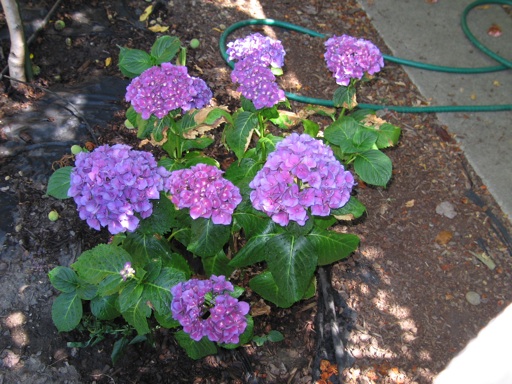
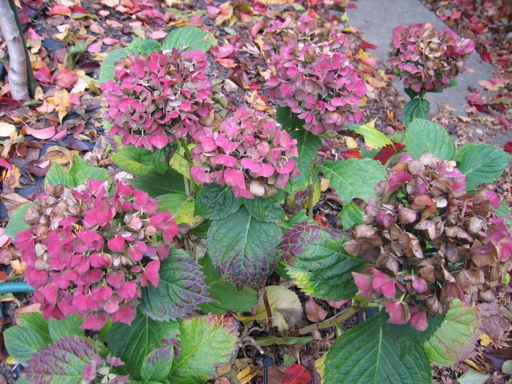
December 14 2008 | Hydrangeas | Comments Off on Thinking of Bigleaf Hydrangeas
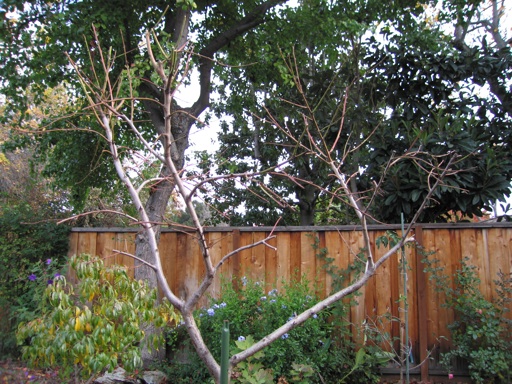
Yesterday, I pruned our peach tree. I prune our peach tree every winter to keep it small and manageable. Our tree is a small 7 year old tree. It only took about 20 minutes to prune.
Last summer, our tree grew vigorously, but some of the newly grown branches were long and weak. I trimmed those branches to prevent them from breaking next summer under the weight of the fruit.
I also cut off all of the high branches above about 10 feet, so that the tree will not develop fruit that is difficult to reach on high branches. I also cut off all of the branches that were sagging down and branches that were crossing or touching other branches. In general, I try to cut off enough branches to keep the tree in a small compact shape.
Recently, I bought a book entitled “How to Prune Fruit Trees” by R. Sanford Martin. This book provides specific details on how home growers should prune fruit trees. According to the book, different techniques should be used when pruning each particular type of fruit tree. For example, peach trees require different pruning techniques than pear trees. I didn’t know that until I read this book. I used to think that the same pruning technique could be applied to all types of fruit trees.
According to this book, ideal pruning techniques require much more attention to detail and the particular type of fruit tree being pruned. The book covers specific pruning techniques for a few dozen different varieties of fruit trees and bushes.
Peach trees develop all of their fruit on new branches that grew during the previous summer. Also, as I have discovered, peach trees tend to set a large number of small sized fruits.
Different sources suggest different techniques for forcing a peach tree to develop a small number of peaches that are large in size. Some sources advise cutting off a portion of the length of each of the new branches and twigs that grew during the previous summer. Cutting off a portion of each new branch will transfer the tree’s energy into the remaining buds, producing larger and better peaches next year. Other sources suggest entirely cutting off a large percentage (e.g, half) of the newly grown branches, while leaving the other new branches untrimmed. Of course, newly grown branches that are too long should be trimmed according to both techniques.
Last summer, our small peach tree produced over 100 small peaches. I was disappointed that the fruit was not larger, and I resolved to do something about it next year. Yesterday, I trimmed all of the newly grown branches and twigs back by about one-half in an attempt to reduce the amount of fruit production next year. I found that the newly grown branches are easy to identify, because they are thin, green and red in color, and are not woody like the older branches.
I will report back on the results next year. If our tree still produces more than about 50 fruits despite the new pruning method, I will thin them out in May.
December 08 2008 | Peaches/Nectarines | Comments Off on Peach Tree Pruning
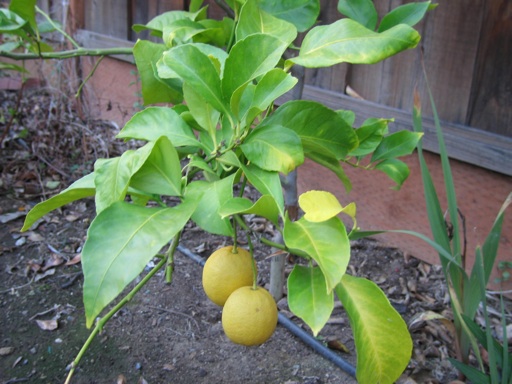
The leaves of my Eureka lemon are starting to turn yellow again, which is a classic sign of nutrient deficiency. It seems odd that the leaves are turning yellow in late fall when the plant is not growing anyway. Usually, yellow leaves appear on my citrus in the spring and summer if I haven’t fertilized them enough.
Completely yellow leaves are usually a sign of nitrogen deficiency, while green veins in the leaves with yellow in between is often caused by a lack of zinc or iron. University of Florida’s website http://edis.ifas.ufl.edu/CH142 has a good summary of the nutrient deficiencies in citrus with pictures. I’ll admit I haven’t been fertilizing it as often as I should. My guess is that nitrogen deficiency is probably the culprit. I just gave it a 10-4-10 citrus fertilizer. Hopefully, that will help.
In our area, many people grow lemon trees in their yards. Most of the lemon trees I have seen in other people’s yards are full of yellow leaves. A few of the lemon trees I have seen are completely covered with yellow leaves. Clearly, these people never bother to fertilize their lemons. Why have one then? Do they think that the leaves are supposed to be yellow just because the fruit is yellow? At least I have been fertilizing mine a few times a year.
Another problem I have had with my Eureka lemon is leaf drop. As soon as the roots get dry, it starts losing leaves. It has happened at least twice already. Last winter was unusually dry here. I stopped watering my lemon regularly, because I figured the daytime temperatures were cool enough (50s F) to prevent it from drying out. But by January, it had lost nearly all of its leaves. I have been watering it nearly everyday since then.
However, now that the daytime highs here are barely reaching above 60 again, I have cut back on watering it. But this time, I plan on continuing to water our lemon about once a week to keep the soil around it from drying out, unless of course it finally starts raining here on regular basis.
Despite all of the problems, citrus is one my favorite fruits to grow. Citrus blossoms are incredibly fragrant. And because lemon plants can produce lemons in all four seasons, one can have a supply of fresh lemons in the yard nearly all year long.
December 06 2008 | Lemons | Comments Off on Eureka Lemon Yellowing







